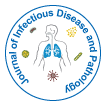Transmission and Epidemiology of Viruses
Received Date: Jun 04, 2022 / Published Date: Jul 05, 2022
Abstract
The infective concentration of a sample of virus may be measured by volumetric analysis during a outlined experimental assay system (e.g., in cell culture or AN animal model), by crucial the very best dilution (i.e., rock bottom concentration) of the sample that may still initiate AN infection, for instance, which will infect five hundredth of the cell cultures (tissue culture infective dose fifty, TCID50) or animals (lethal dose fifty, LD50; or infective dose fifty, ID50) used for measuring. It’s expressed as variety per volume, for instance, a hundred LD50 per cc. One LD50 usually represents more than one virus particle as (1) typically several of the incoming virus particles are non-infective thanks to defective assembly, genetic errors, or inactivation caused by environmental conditions, etc., and (2) typically several or most interactions between infective particles and cells don't cause a productive infection at the tissue/organ/individual level.
Keywords: Epidemiology; Infection virus; Transmission virus
Citation: Tregoning JS (2022) Transmission and Epidemiology of Viruses. J Infect Pathol, 5: 151. Doi: 10.4172/jidp.1000151
Copyright: © 2022 Tregoning JS. This is an open-access article distributed under the terms of the Creative Commons Attribution License, which permits unrestricted use, distribution, and reproduction in any medium, provided the original author and source are credited.
Share This Article
Recommended Journals
Open Access Journals
Article Tools
Article Usage
- Total views: 1051
- [From(publication date): 0-2022 - Apr 16, 2025]
- Breakdown by view type
- HTML page views: 725
- PDF downloads: 326
